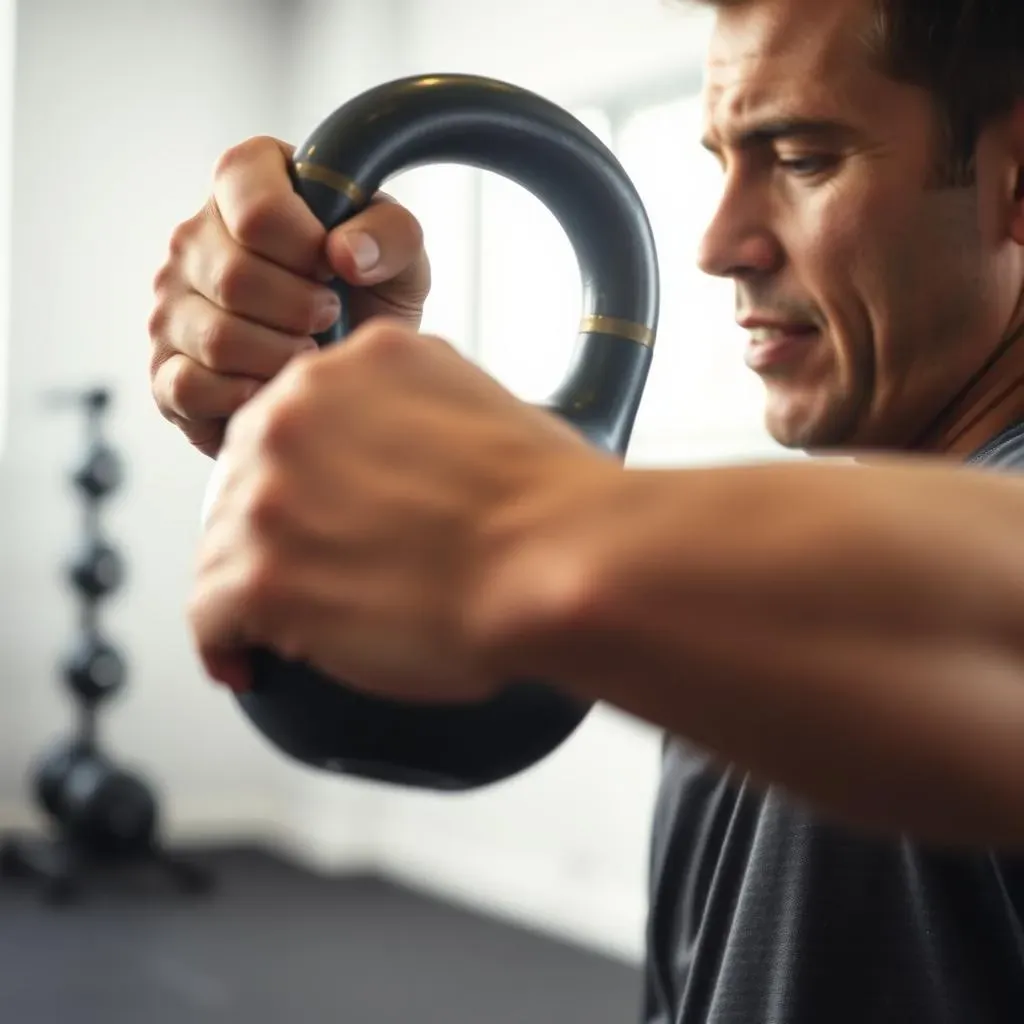Table of Contents
Ready to sculpt your dream physique and boost your fitness game? Then get ready to unleash the power of kettlebells with our comprehensive guide to the ultimate 4 day kettlebell workout! This isn't your grandma's workout; we're talking about a dynamic, full-body program designed to challenge you, build lean muscle, and torch calories. Forget boring routines – we'll equip you with the knowledge and a structured plan to maximize your results. First, we'll help you choose the right kettlebells for your fitness level, ensuring you have the perfect tools for success. Then, we'll dive into a sample 4-day kettlebell workout routine, carefully designed for optimal muscle growth and overall fitness. Mastering the kettlebell swing is crucial, so we'll break down the proper technique and progressions to avoid injury and maximize your gains. Finally, we'll explore advanced exercises and variations to keep your workouts fresh and challenging, pushing you to reach your peak performance. Are you ready to embark on this fitness adventure? Let's get started!
Choosing Your Kettlebells: Weight, Size, and Style

Choosing Your Kettlebells: Weight, Size, and Style
Finding Your Perfect Kettlebell Weight
Picking the right kettlebell weight is crucial for a safe and effective 4 day kettlebell workout. Too light, and you won't see results. Too heavy, and you risk injury. Start with a lighter weight, even if you're pretty strong. Think of it like this: you're learning a new skill, and you don't want to trip over yourself before you even get going! Focus on proper form first – you can always increase the weight later. A good starting point is to choose a weight you can comfortably perform 10-15 reps with good form. If you're a complete beginner, consider starting with a beginner kettlebell routine and a lighter weight kettlebell (8-12kg for women, 12-16kg for men) to build your strength and technique. Don't be afraid to start small and work your way up. Remember, consistency is key!
Once you feel comfortable with the lighter weight, gradually increase the weight as your strength improves. Remember, you should always prioritize proper form over lifting heavier weights. If you find yourself struggling to maintain proper form, it's time to drop the weight back down. It's better to do fewer reps with perfect form than many reps with sloppy form. Check out some beginner kettlebell workouts for ideas to build your strength and confidence.
Fitness Level | Suggested Starting Weight (kg) |
|---|---|
Beginner | 8-12 (women), 12-16 (men) |
Intermediate | 12-16 (women), 16-20 (men) |
Advanced | 16+ (women), 20+ (men) |
Kettlebell Styles and Sizes: Cast Iron vs. Vinyl, and More
You'll find kettlebells come in various materials and styles. Cast iron kettlebells are the most common and durable, offering a classic feel and excellent weight distribution. However, they can be quite heavy and might not be ideal for beginners or those with limited space. Vinyl-coated kettlebells are a lighter, more beginner-friendly option, often preferred for home workouts due to their reduced noise and gentler impact on floors – perfect if you’re working out in an apartment. They're also easier to clean. Adjustable kettlebells offer a cost-effective solution if you're unsure about which weight is right for you. They allow you to adjust the weight as your strength increases, saving you money in the long run. Consider your budget and storage space when making your decision. Some people prefer a full body kettlebell workout using one weight, while others like a variety.
Beyond the material, consider the handle. A comfortable grip is essential to prevent blisters and improve your overall workout experience. Look for a kettlebell with a textured handle for a better grip. The size of the kettlebell also matters, especially for certain exercises. Larger kettlebells are generally better suited for swings and cleans, while smaller ones might be more comfortable for presses and snatches. A good starting point is to get a couple of kettlebells in different weights, allowing you to experiment and find what works best for you. Remember to consult a fitness professional if you have any questions or concerns about choosing the right kettlebell for your needs. If you're a beginner, a beginner kettlebell program can provide excellent guidance.
- Cast Iron: Durable, classic, heavier
- Vinyl-coated: Lighter, quieter, easier to clean
- Adjustable: Cost-effective, adaptable to strength gains
Sample 4Day Kettlebell Workout Routine: A Balanced Approach

Sample 4Day Kettlebell Workout Routine: A Balanced Approach
Day 1: Legs and Core
We're kicking things off with a lower body focus. This day targets your quads, hamstrings, glutes, and core. Think powerful movements that build strength and stability. We'll be using kettlebell swings, goblet squats, and lunges. These exercises are fantastic for building functional strength, meaning you'll not only look stronger but also feel more capable in everyday life. A strong core is essential for stability and injury prevention, so we'll integrate core work throughout the workout. Remember to maintain proper form throughout the exercises to maximize effectiveness and avoid injury. It's always better to do fewer reps with perfect form than many with sloppy form. If you're feeling overwhelmed, start with a beginner full-body kettlebell workout to build a solid foundation before tackling this routine.
For the kettlebell swings, focus on using your hips to generate power, keeping your back straight and your core engaged. For goblet squats, hold the kettlebell close to your chest and sit back into the squat, keeping your chest up. Lunges should be performed with control, ensuring that your knee doesn't go past your toes. Remember to choose a weight that challenges you without compromising your form. If you're unsure about the correct form, watch some videos online or consult a fitness professional. Remember to prioritize proper form, even if it means using a lighter weight. A beginner kettlebell workout can help you master these essential movements.
- Kettlebell Swings: 3 sets of 10-12 reps
- Goblet Squats: 3 sets of 10-12 reps
- Kettlebell Lunges: 3 sets of 10-12 reps per leg
- Plank: 3 sets, hold for 30-60 seconds
Day 2: Upper Body Power
Today, we're focusing on your upper body, building strength and power in your shoulders, arms, and back. We'll incorporate kettlebell presses, rows, and cleans. Kettlebell presses are a great way to build shoulder strength and definition. Kettlebell rows are excellent for building back strength and improving posture. Kettlebell cleans are dynamic movements that engage multiple muscle groups simultaneously, building both strength and coordination. Remember, proper form is paramount – don't sacrifice it for more weight. A solid foundation is key to avoiding injury and seeing results.
For kettlebell presses, maintain a stable base and use your legs to help you push the kettlebell overhead. For rows, keep your back straight and pull the kettlebell towards your chest, squeezing your shoulder blades together. For cleans, focus on a smooth, controlled movement, using your hips to generate power. Remember to breathe deeply throughout each exercise and focus on maintaining good posture. If you find yourself struggling with any particular exercise, consider reducing the weight or breaking it down into smaller, more manageable steps. Try checking out some two-handed kettlebell exercises for extra help.
Exercise | Sets | Reps |
|---|---|---|
Kettlebell Press | 3 | 8-10 |
Kettlebell Row | 3 | 10-12 |
Kettlebell Clean | 3 | 5-8 |
Day 3: Active Recovery and Core
This is your active recovery day. It's not a rest day; instead, we'll focus on lighter cardio and core work. Think light jogging, cycling, or swimming – anything that gets your heart rate up without putting too much strain on your muscles. This helps improve blood flow, reduce muscle soreness, and promote overall recovery. We'll also incorporate some core exercises to strengthen your abdominal muscles and improve stability. A strong core is crucial for overall fitness, helping to prevent injuries and improve performance in other exercises.
For core work, consider exercises like planks, Russian twists, and leg raises. These exercises target your abdominal muscles from different angles, promoting overall core strength and stability. Remember to maintain proper form and focus on controlled movements. Don't rush through the exercises, and don't compromise form for speed. Listen to your body; if you feel any pain, stop immediately. Remember that consistency is key to achieving your fitness goals. Even on your active recovery days, strive for consistency in your routine. A consistent workout schedule is crucial for seeing results. If you need a shorter workout, try a 15-minute beginner kettlebell workout.
- Light Cardio (30 minutes)
- Plank: 3 sets, 30-60 seconds hold
- Russian Twists: 3 sets of 15-20 reps per side
- Leg Raises: 3 sets of 15-20 reps
Mastering the Kettlebell Swings: Technique and Progressions

Mastering the Kettlebell Swings: Technique and Progressions
The Russian Kettlebell Swing: Your Foundation
The kettlebell swing isn't just about brute force; it's about harnessing your hips and core for explosive power. Think of it like a pendulum—smooth, controlled, and powerful. Start with a lighter weight kettlebell to master the movement. Stand with feet shoulder-width apart, kettlebell between your legs. Hinge at your hips, keeping your back straight, and swing the kettlebell back between your legs. Then, explosively drive through your hips, swinging the kettlebell upward to chest height (or slightly higher), squeezing your glutes at the top of the movement. Let the kettlebell's momentum carry it back down, repeating the motion. Focus on the hip hinge and the explosive movement from your hips; don't rely solely on your arms. It's all about the power generated from your lower body transferring up through your core.
Common mistakes include rounding your back, using your arms to lift the kettlebell, and not fully extending your hips. Remember, this is a hip-driven movement, not an arm movement. Practice in front of a mirror to check your form. Start slow, focusing on perfect form before increasing your speed and weight. If you're struggling, try breaking down the movement into smaller parts, focusing on each step individually. A good way to start is to check out some beginner kettlebell programs focusing on proper form.
- Maintain a straight back
- Engage your core throughout the movement
- Use your hips to generate power
- Control the kettlebell's momentum
Progression: From Basic to Advanced
Once you've mastered the basic Russian kettlebell swing with good form, you can gradually progress to more advanced variations. One way to increase the challenge is to increase the weight of your kettlebell. Another is to increase the number of repetitions or sets. You can also try incorporating different types of swings, such as the American kettlebell swing (swinging the kettlebell overhead), or incorporating kettlebell swings into more complex exercises, such as the kettlebell snatch. Remember to always prioritize proper form over speed or weight.
Remember, progression should be gradual and consistent. Don't jump to heavier weights too quickly. Listen to your body and take rest days when needed. If you feel any pain, stop immediately. Proper form is essential for injury prevention and maximizing your results. Consider adding a kettlebell core workout to strengthen your core and improve your stability for even better swings. A strong core is essential for proper form and preventing injuries.
Progression Stage | Focus |
|---|---|
Beginner | Mastering basic swing technique with light weight |
Intermediate | Increasing reps, sets, and weight |
Advanced | Incorporating advanced variations and complex movements |
Advanced Kettlebell Exercises and Workout Variations: Level Up Your Training

Advanced Kettlebell Exercises and Workout Variations: Level Up Your Training
Kettlebell Snatch: Explosive Power
Ready to take your kettlebell game to the next level? Let's talk about the kettlebell snatch—a full-body exercise that demands strength, power, and coordination. It's a dynamic movement that combines a clean with an overhead press, engaging almost every muscle group. It's not for the faint of heart, but mastering the snatch will significantly boost your overall fitness. Start with a lighter weight than you think you need; focus on technique before adding weight. Remember, the kettlebell snatch is a powerful exercise, so proper form is critical to avoid injury. If you need some extra help, check out our guide to four of the best kettlebell exercises to build a strong foundation.
The key to a successful snatch is a smooth, controlled movement. Don't rush the lift; focus on each phase of the movement, ensuring that your form remains impeccable. If you're struggling with any aspect of the snatch, consider breaking the exercise down into smaller, more manageable parts, focusing on mastering each step individually before combining them. It's better to perform fewer reps with perfect form than many with poor form. Remember, consistency and patience are key. Don't get discouraged if you don't master it overnight; keep practicing, and you'll get there. For some extra tips on perfecting your form, take a look at our beginner kettlebell program.
- Start with a lighter weight
- Focus on proper technique
- Break down the movement into smaller parts
- Be patient and persistent
Turkish Get-Ups: Full-Body Control
The Turkish get-up (TGU) isn't just an exercise; it's a full-body movement that tests your strength, balance, and coordination. It's a complex exercise that requires a lot of practice to master. It’s like a flowing sequence of movements, starting from a lying position and ending standing, all while holding a kettlebell. It's a fantastic way to improve your core strength, shoulder stability, and overall body control. Start with a lighter weight and focus on perfecting the technique before increasing the weight. The TGU is a great way to build strength and improve your balance. Make sure you watch videos and practice slowly at first. You can find some helpful exercises in our guide to two-handed kettlebell exercises.
The TGU involves a series of controlled movements, requiring you to maintain balance and stability throughout. Remember to engage your core and use your breath to control the movement. The TGU is a challenging exercise, but the rewards are significant. It improves your overall strength, balance, and coordination. If you're struggling, break it down into smaller parts, and focus on mastering each step individually. It's better to do fewer reps with perfect form than many with poor form. Remember, consistency and patience are key. With consistent practice, you'll gradually improve your strength, coordination, and balance. Consider adding these exercises to a full-body kettlebell workout for beginners to improve your overall fitness.
Phase | Description |
|---|---|
Lie Down | Start lying on your back with the kettlebell in one hand |
Roll Over | Roll onto your side, then to your elbow |
High Plank | Transition to a high plank position |
Knee to Chest | Bring one knee to your chest |
Stand Up | Stand up while maintaining balance |
Reverse | Reverse the process to return to lying position |